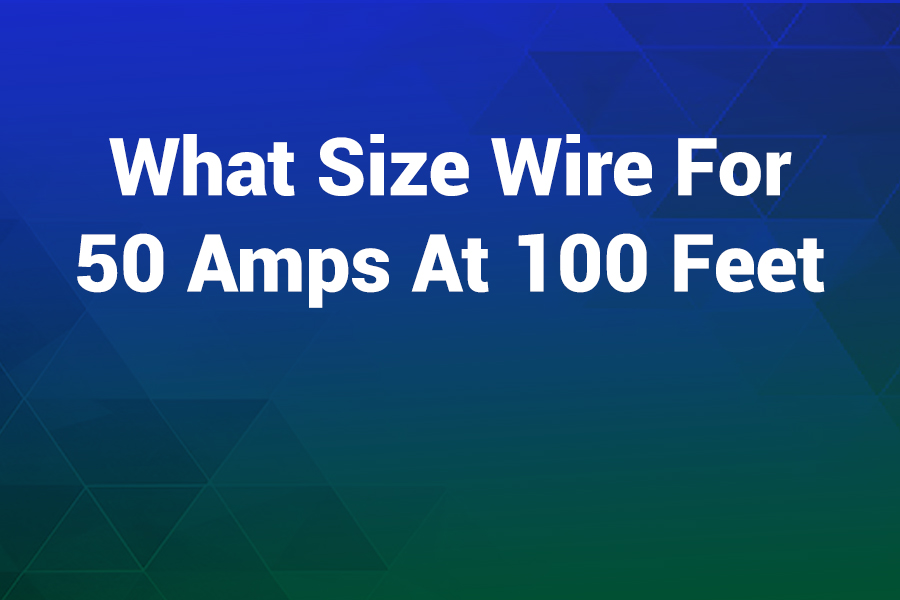Running a 50-amp circuit over 100 feet demands more than just following a breaker rating — you must minimize voltage drop and meet code.
In this article you’ll learn exactly what wire gauge to use (copper or aluminum), how to calculate voltage drop, when to upsize, and what trade-offs matter. You’ll leave with confidence on sizing a heavy 50 A run correctly, safely, and code-compliant.
Why Wire Size Matters on Long Runs
Electric wires resist current flow, and over longer distances this resistance causes voltage to drop. If your equipment sees too little voltage, motors underperform, electronics misbehave, and heating or lighting loads may flicker or fail.
The National Electrical Code (NEC) suggests keeping voltage drop under 3 % for feeders or branch circuits to maintain efficiency and safety. Because 100 feet introduces nontrivial resistance, a basic “use #6 for 50 A” rule often fails when run length increases.
Temperature, insulation type, and conductor bundling also influence how much current the wire can safely carry (ampacity). You must choose a wire size that handles the ampacity plus mitigates voltage loss.
Basic Ampacity Minimum for 50 A
Under normal circumstances (short runs, standard ambient conditions), NEC charts require:
- 6 AWG copper or
- 4 AWG aluminum (or copper-clad aluminum)
These are minimums for a 50-amp branch circuit in typical installations.
However, when your run is 100 feet, the increased voltage drop often forces you to use a larger gauge to maintain acceptable voltage levels.
Voltage Drop Calculation (Simplified)
To estimate additional sizing needs, you can use the formula:
Voltage drop = (2 × Length in feet × Current × Resistivity) ÷ Cross-sectional area
Or more practically, most electricians use voltage-drop tables. For a 50 A load at 100 ft with copper, the voltage drop on 6 AWG is close to or exceeding the acceptable 3 % threshold under full load. To stay under 3 %, many installers jump to 4 AWG copper for the 100-foot run.
For aluminum, whose conductivity is lower, the drop is worse. So instead of 4 AWG aluminum, you may need 2 AWG aluminum to keep voltage drop in range for that same distance.
Recommended Wire Size for 50 A at 100 ft
Given the factors above, the best choices are:
| Conductor Material | Recommended Wire Gauge | Why |
| Copper | 4 AWG | Keeps voltage drop below ~3 % at full load over 100 ft |
| Aluminum | 2 AWG | Compensates for lower conductivity and higher voltage drop |
You could theoretically stick with 6 AWG copper or 4 AWG aluminum, but only if your load never nears 50 A and voltage drop is permissible — not a safe bet for many applications.
Ground and Neutral Considerations
In a 4-wire 240/120 V setup, your equipment ground (EGC) can often be a smaller gauge per NEC tables — for example, 8 AWG copper ground might suffice — but your two hot conductors and neutral (if present) must match the 4 AWG copper size in the scenario above. Always confirm the local code and panel manufacturer specs.
Practical Examples
If you’re running power to a detached garage with a heavy load like EV charger or air compressor, you’ll likely use the 4 AWG copper recommendation. In a mobile home park or RV site run using aluminum to cut cost, you’d opt for 2 AWG aluminum to avoid serious loss.
If your real load is lower (say 30 A), you might carefully stay with 6 AWG copper — but that’s riskier under higher demands. A sound design uses the heavier wire so you never push limits.
Insulation, Temperature & Installation Factors
Your wire rating depends on the insulation class (e.g. 60 °C, 75 °C, 90 °C) and ambient temperature. If your wire runs through hot attics or crowded conduits, derating may require additional upsizing. Always use the lowest rated termination point in your system to decide your safe ampacity limit.
In conduit, wires run together may heat each other, so divergent derating rules apply. Also, copper’s performance degrades less under heat than aluminum.
When Could You Use Smaller Wire?
In rare cases, if your load is far under 50 A (say 20 A continuous), 6 AWG copper might suffice for 100 ft without exceeding 3 % drop. Or for noncritical circuits or lighting where 5 % drop tolerances are allowed, you might use standard minimum size. But for full 50 A capacity, always upsize.
Conclusion
For a full-capacity 50 A run over 100 feet: use 4 AWG copper or 2 AWG aluminum to keep voltage drop under control and meet NEC guidance.
Don’t gamble with minimums under long runs. Plan for future expansion, derating factors, and always adhere to local code. Do your calculations, stay under 3 % drop, and you’ll end up with a safe, efficient system.

